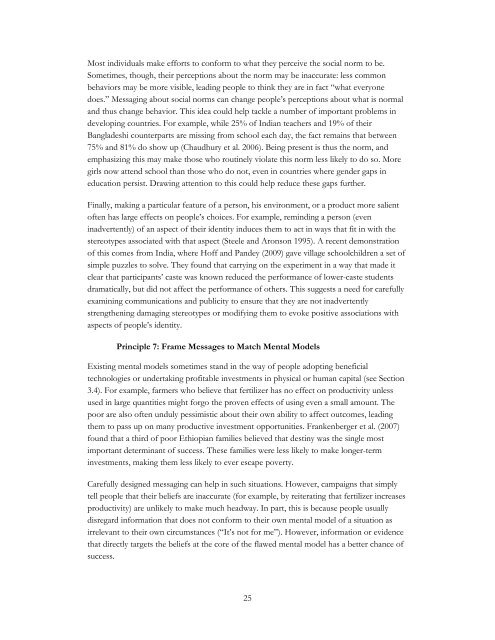1426679 file datta mullainathan behavioral design
1426679 file datta mullainathan behavioral design
1426679 file datta mullainathan behavioral design
Create successful ePaper yourself
Turn your PDF publications into a flip-book with our unique Google optimized e-Paper software.
Most individuals make efforts to conform to what they perceive the social norm to be.<br />
Sometimes, though, their perceptions about the norm may be inaccurate: less common<br />
behaviors may be more visible, leading people to think they are in fact “what everyone<br />
does.” Messaging about social norms can change people’s perceptions about what is normal<br />
and thus change behavior. This idea could help tackle a number of important problems in<br />
developing countries. For example, while 25% of Indian teachers and 19% of their<br />
Bangladeshi counterparts are missing from school each day, the fact remains that between<br />
75% and 81% do show up (Chaudhury et al. 2006). Being present is thus the norm, and<br />
emphasizing this may make those who routinely violate this norm less likely to do so. More<br />
girls now attend school than those who do not, even in countries where gender gaps in<br />
education persist. Drawing attention to this could help reduce these gaps further.<br />
Finally, making a particular feature of a person, his environment, or a product more salient<br />
often has large effects on people’s choices. For example, reminding a person (even<br />
inadvertently) of an aspect of their identity induces them to act in ways that fit in with the<br />
stereotypes associated with that aspect (Steele and Aronson 1995). A recent demonstration<br />
of this comes from India, where Hoff and Pandey (2009) gave village schoolchildren a set of<br />
simple puzzles to solve. They found that carrying on the experiment in a way that made it<br />
clear that participants’ caste was known reduced the performance of lower-caste students<br />
dramatically, but did not affect the performance of others. This suggests a need for carefully<br />
examining communications and publicity to ensure that they are not inadvertently<br />
strengthening damaging stereotypes or modifying them to evoke positive associations with<br />
aspects of people’s identity.<br />
Principle 7: Frame Messages to Match Mental Models<br />
Existing mental models sometimes stand in the way of people adopting beneficial<br />
technologies or undertaking profitable investments in physical or human capital (see Section<br />
3.4). For example, farmers who believe that fertilizer has no effect on productivity unless<br />
used in large quantities might forgo the proven effects of using even a small amount. The<br />
poor are also often unduly pessimistic about their own ability to affect outcomes, leading<br />
them to pass up on many productive investment opportunities. Frankenberger et al. (2007)<br />
found that a third of poor Ethiopian families believed that destiny was the single most<br />
important determinant of success. These families were less likely to make longer-term<br />
investments, making them less likely to ever escape poverty.<br />
Carefully <strong>design</strong>ed messaging can help in such situations. However, campaigns that simply<br />
tell people that their beliefs are inaccurate (for example, by reiterating that fertilizer increases<br />
productivity) are unlikely to make much headway. In part, this is because people usually<br />
disregard information that does not conform to their own mental model of a situation as<br />
irrelevant to their own circumstances (“It’s not for me”). However, information or evidence<br />
that directly targets the beliefs at the core of the flawed mental model has a better chance of<br />
success.<br />
25


